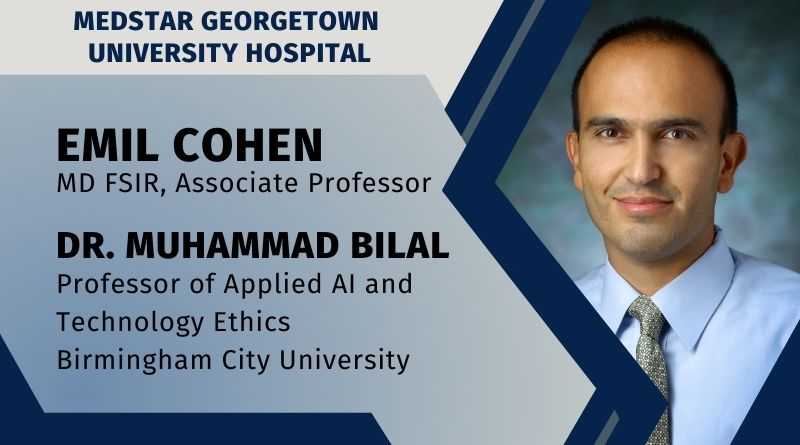Empowering Innovation Through Collaboration, Small Teams and AI-Driven Healthcare Solutions
By Emil Cohen, MD FSIR, Associate Professor, MedSTAR Georgetown University Hospital, and Dr. Muhammad Bilal, Professor of Applied AI and Technology Ethics, Birmingham City University
The power to create and innovate is becoming more accessible to individuals worldwide. Modern tools and platforms have made it easier than ever to connect with experts who share similar interests, regardless of geographical barriers. The democratization of creative power is reshaping industries and fostering collaborations that were once impractical. To keep up with the rapidly evolving landscape, organizations need to shift their focus towards investing in smaller, more agile teams. The future of research lies in a model where smaller teams work together on diverse approaches to problem-solving. Achieving optimal results will require leadership that can lead this motley cohort of groups.
The field of medical imaging is currently undergoing significant changes. While medical imaging data has long been digitized, the challenges of acquiring data with minimal patient harm and accurately interpreting scans to diagnose complex diseases remain unresolved. Recent advances in AI have made strides in helping doctors diagnose conditions more quickly, and research in this area continues to intensify. To achieve impactful results, it’s crucial that teams are composed of experts from various disciplines who also have a deep understanding of each other’s work.

Enhancing Imaging Techniques with AI
Angiographic procedures are vital for diagnosing and treating cardiovascular diseases, but its gold standard technique, x-ray angiography, comes with significant radiation exposure. The use of ionizing radiation, such as X-rays, carries inherent risks, from minor skin burns to cancer induction.
AI-driven innovations can make a significant difference in this context, particularly in optimizing imaging processes to reduce the radiation dose without sacrificing image quality. The ultimate goal is not just improving patient safety, but also protecting healthcare providers from excessive radiation exposure.
The Advantage of Smaller Teams
Historically, large-scale AI projects in healthcare have faced considerable challenges. The table below highlights four examples of major projects that, despite significant investments in capital and manpower, failed to achieve their full promised potential.
| Example | Challenges Faced | Lessons Learned |
| IBM Watson in Healthcare | Integration with Clinical Workflows, Data Quality and Accessibility, Communication Barriers, Regulatory and Ethical Considerations | Interdisciplinary Teams, Continuous Feedback and Iteration, Education and Training |
| Google’s AI for Diabetic Retinopathy Screening | Clinical Workflow Integration, Data Variability | Better integration with clinical workflows, Improved data quality and representation |
| Microsoft’s InnerEye for Radiotherapy Planning | Adoption Resistance, Technical Challenges | Enhanced collaboration with radiologists, Transparent algorithms |
| PathAI in Pathology | Data Labeling Issues, Regulatory Hurdles | Accurate data labeling, Close collaboration for regulatory compliance |
The increasing availability of technology and the ability to collaborate with experts around the globe are transforming the landscape of innovation.
These examples highlight the importance of effective collaboration and communication within interdisciplinary teams. However, it’s worth considering whether smaller teams with overlapping expertise might have handled these challenges more effectively. Currently, AI and machine learning in medicine often follow a top-down approach, with experts in each field setting the stage for broader development. This model could improve by involving small groups of clinical and technology experts early on, allowing them to provide feedback that helps steer projects towards more practical solutions with real clinical utility. These groups don’t need to be made up of world-renowned experts in their fields, but they should have a solid grasp of both technology and everyday healthcare practices in their respective specialties.
Smaller teams tend to exhibit greater flexibility and cohesiveness, leading to more successful outcomes [REF]. Studies have shown that smaller research teams often produce more innovative and high-impact work compared to larger groups, partly due to enhanced communication and cooperation. By allocating resources to multiple small groups, in addition to large projects, we have the opportunity to increase the likelihood of success. This approach has proven unexpectedly effective in the defense industry with the Defense Advanced Research Projects Agency (DARPA) and is now being applied to healthcare through the Advanced Research Projects Agency for Health (ARPA-H).
In our collaboration, as a doctor with a background in computer science, I bring clinical insights and patient care knowledge to the table. My partner in England, Prof. Bilal, is an expert in computer science and machine learning, contributing his extensive technical expertise in AI-driven healthcare projects. Our overlapping skills enable us to set realistic and achievable goals, avoiding the pitfalls of setting unattainable expectations.
Resource Diversification in Healthcare
Resource diversification is a well-established strategy to achieve goals and a honed workforce in the business community, and it’s time for healthcare to adopt this approach. Traditionally, resources have been frequently concentrated among a small group of researchers within most healthcare institutions. This was necessary since the tools for research were costly and required dedicated time from researchers.
Today, however, AI tools have significantly lowered entry for the average physician, and the internet landscape has made cross-border and cross-discipline collaboration more accessible. This opens the doors for many small, agile research groups to use the company’s resources more efficiently to achieve their goals. At the same time, strategic management is crucial to allocate resources efficiently and cut waste when necessary.
The increasing availability of technology and the ability to collaborate with experts around the globe are transforming the landscape of innovation. Our collaboration between the United States and England exemplifies the power of combining diverse expertise to tackle perennial healthcare challenges. By leveraging all available tools, we are improving imaging techniques and reducing radiation exposure, ultimately enhancing both patient care and physician safety. As we look to the future, we remain committed to pushing the boundaries of what is possible through global collaboration, smaller teams, and technological innovation.

